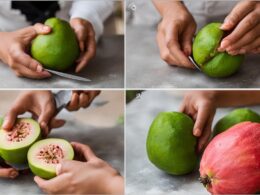Welcome to our guide on how to ripen plums at home! Whether you’ve harvested plums from your garden or brought home a batch from the market, we’ll show you the best methods to achieve perfectly ripe and delicious plums. By understanding the plum ripening process and following a few simple steps, you’ll be enjoying juicy and sweet plums in no time.
To begin, let’s explore the plum ripening process. Plums naturally release a gas called ethylene as they ripen, which is responsible for the fruit’s softness, sweetness, and vibrant color. By harnessing the power of ethylene, we can accelerate the ripening process and enjoy ripe plums sooner.
One of the easiest and most effective methods to ripen plums is by placing them in a clean paper bag. The paper bag traps the ethylene gas emitted by the plums, creating a controlled environment that speeds up the ripening process. Remember to avoid using plastic bags, as they can restrict airflow and affect the taste of the plums.
If you’re looking to ripen plums even faster, you can add a ripe banana to the paper bag. Bananas also release ethylene gas, which will further accelerate the ripening process of the plums. However, if you prefer to ripen plums naturally without adding a banana, using only the paper bag method will still yield great results.
Alternatively, if you don’t have a paper bag handy, you can ripen plums by placing them in a fruit bowl. Although it may take slightly longer for the plums to ripen using this method, it can still be effective. Just be patient and check for ripeness regularly.
Now that you know the basics of how to ripen plums, you’re ready to enjoy the fruits of your labor. In the following sections, we’ll dive deeper into the different plum varieties, how to identify and harvest ripe plums, and storage tips to extend the shelf life of your perfectly ripened plums. So let’s get started!
Understanding Plums and Their Ripening Process
Plums come in a variety of types, including Japanese plums, European plums, and American plums. Each type has its own unique characteristics that contribute to the overall flavor and ripening process.
Japanese plums are known for their large size and sweet taste. These plums have a firm texture and a vibrant range of colors, such as red, purple, and yellow. They are often enjoyed fresh or used in desserts and preserves.
European plums, on the other hand, are smaller in size and have a less sweet taste compared to Japanese plums. Their skin ranges from dark blue to purple, and they have a juicy and slightly tart flavor. European plums are commonly used in baked goods, jams, and jellies.
American plums have a distinctively tart taste and are usually smaller in size. They come in shades of red, purple, and yellow, with a firm flesh. American plums are commonly used in cooking, such as in sauces, chutneys, and pickles.
When it comes to ripening plums, the process can vary depending on the type of plum. Japanese plums tend to ripen faster and are often picked when they are slightly firm but with a sweet aroma. European and American plums, on the other hand, are usually left to ripen on the tree, ensuring they develop their full flavor before being harvested.
Ripening plums off the tree can be done by placing them in a paper bag with a ripe banana. The ethylene gas emitted by the banana will hasten the ripening process. Alternatively, you can leave the plums at room temperature in a cool, dark place, allowing them to ripen naturally over a few days. Remember to check the plums regularly to ensure they reach the desired ripeness.
Understanding the different plum varieties and their ripening process allows you to select the right type of plum for your desired flavor and ensures that you can enjoy ripe and delicious plums throughout the year.
Identifying and Harvesting Ripe Plums
Ripe plums have several identifiable characteristics. When plums ripen, their colors undergo a transformation. Red plums become deeper in color, while purple plums turn almost black. Green plums change to a vibrant yellow, and yellow plums take on a golden hue.
Ripe plums also have a unique texture. They are slightly soft to the touch, giving a gentle yield when pressed. In addition, their skin develops a delicate powdery appearance, which is a sign of optimal ripeness. When examining a ripe plum, pay attention to the stem as well. It should be slightly soft and brown, indicating that the fruit is ready for harvesting.
Conclusion
Overall, ripening plums at home is a simple and rewarding process that allows you to enjoy the full flavor and sweetness of this delicious fruit. By using either a paper bag or a fruit bowl, you can accelerate the ripening process and relish in the juicy goodness of perfectly ripe plums. Whether you prefer to enjoy them fresh or incorporate them into various recipes, the choice is yours.
When it comes to storing ripe plums, it’s crucial to ensure their longevity and freshness. To extend their shelf life, store ripe plums in the crisper drawer of your refrigerator. The cool temperature helps to maintain their texture and taste, so you can savor them over an extended period.
Once your plums are perfectly ripened and properly stored, the opportunities for enjoyment are endless. Savor the sweetness of ripe plums in delectable recipes, such as plum cakes, pies, or even prunes. For a unique twist, you can even infuse plums into vodka for a flavorful and refreshing cocktail.
Can I Use the Same Methods to Ripen Passion Fruit as I Would with Plums?
Yes, the same methods can be used to ripen passion fruit as with plums. Both fruits can be left at room temperature to ripen, and can benefit from being stored with a ripe banana to speed up the process. Consider the growing passion fruit stages when choosing the best method for ripening.










